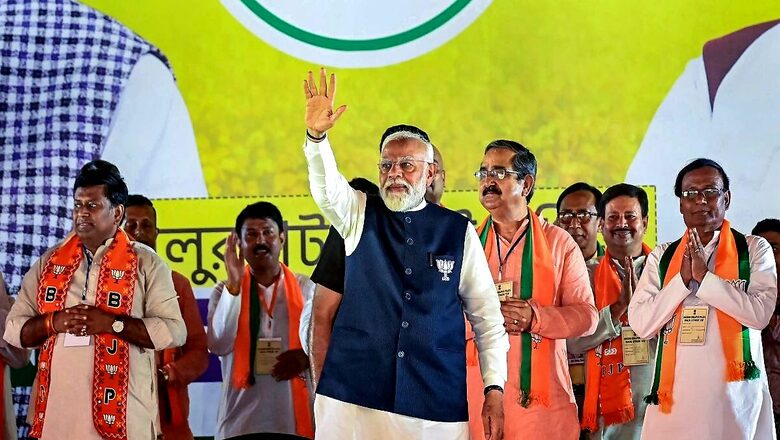
views
As Bengal started warming up to the election mood at the beginning of this year, one incident and the following chain of events catapulted the state’s politics to the national stage. A team of the Enforcement Directorate (ED) officers along with paramilitary forces were assaulted by a mob in Sandeshkhali, a village in the North 24 Parganas. When the team arrived to raid the house of Sheikh Shahjahan — a local Trinamool Congress (TMC) leader — in connection with a Calcutta High Court-monitored investigation on the multi-crore ration distribution scam in the state, he managed to escape but was arrested 55 days later by the state police, only after the high court turned on the heat.
In the meantime, women in Sandeshkhali had erupted in protest, coming out on the streets in hordes carrying brooms and sticks. As the electronic media descended in the village, the women shared stories of suffering at the hands of Sheikh Shahjahan and his acolytes—stories so shocking they seemed ripped from the pages of a fantasy novel. The allegations ranged from forcible usurpation of agricultural lands and converting them to shrimp cultivation ponds to terrorising Opposition political workers, but most scandalously, sexual exploitation of village women in the local party office for years.
Before the state government got a chance to recover from the impact of Sandeshkhali, it was hit by regular stinging criticism from the judiciary, on various counts and orders, that exposed massive corruption in the administration. Several ministers and leaders of the TMC were already in prison and not long ago, the most vocal member of parliament of the party was expelled on serious charges of malpractices. As the elections began, two big judgements shook the TMC government.
On April 22, the Calcutta High Court revoked the appointment of over 25,000 teachers and non-teaching staff. Approximately a month later, the court also invalidated all Other Backward Classes (OBC) certificates issued by the government after 2010, impacting an estimated 500,000 people. The state government had at the same time been facing organised protests on the issues of recruitment in government jobs and daily allowance rates for state government employees.
To state it briefly, the theatre of general elections opened in a manner that would be considered a dream sequence by any Opposition party. While the TMC appeared to be struggling to recover lost ground, the state BJP leadership and workers appeared euphoric, as if the party had already won and were just waiting for the verdict on June 4. Instead, their hopes and dreams crashed on that day.
The question plaguing the minds of many in and out of Bengal is how and where did the BJP lose the plot and how did the TMC achieve such a resounding turnaround.
At this stage, one can only attempt a preliminary analysis of the poll results. However, a cursory glance at the actual poll performance shows that the BJP’s performance is not as poor when compared to the past and under prevailing conditions. It appears disastrous only when compared to high expectations.
Before the Modi wave of 2014 when the BJP obtained 17 per cent vote share in Bengal, its best performance was in the 1999 general elections when it had allied with its current arch rival TMC to get 11 per cent votes. The BJP’s vote share made a steep jump to 40.6 per cent in 2019, just three percentage points lesser than the TMC. However, it lost two percentage points in vote share in the 2021 Assembly elections. Against an announced target of 200 seats, the party managed to win just 77. The vote share in 2024 has actually increased marginally. Thus, rather than being a disaster, the performance of the party has remained more or less at 2021 levels, with marginal improvement.
The problem is that a political party cannot stagnate for long. Either it grows or its support base disappears, as has happened in the case of the Left Front and the Congress in Bengal. With the state Assembly elections to be held within the next two years, the real question is whether the BJP can grow to meet expectations in the near future.
Needless to emphasise, if the BJP has to grow in Bengal, it must address the inhibiting factors. These factors can be categorised into three buckets: (a) organisational, (b) policy and communication, and (c) image-related. Since the 2021 elections, expectations for the BJP’s performance had been rising. However, the extensive media coverage of the polls exposed the party’s organisational weaknesses at the booth level. The BJP failed to counter the ruling party’s multi-tier booth management strategy, which included voter intimidation tactics to prevent them from reaching polling stations and restricting the movement of the candidates by mobbing them.
One of the biggest factors hampering the growth of local-level leadership has been consistent violence before, during and after elections. The National Human Rights Commission’s findings and the high court’s observations on the state administration’s complicity were nothing short of damning. Last week, the court even remarked that if post-poll violence persists, central armed police forces would need to remain deployed in the state for the next five years.
The organisational weakness at the top is of a different nature. To start with, there is no clear chain of command, and little coordination, agreement, or even trust seems to exist between the current state BJP president, the previous president, and the Leader of the Opposition. There are obvious differences among them in their ability to organise and inspire party cadres as well as in their ability to craft a narrative that effectively challenges the TMC government. Despite the myriad problems plaguing the state government, any attempts at a mass movement or even protests have been noticeably absent.
The lack of credible leadership has inevitably led to conflicts between groups within the party, each loyal to a particular leader. This lack of trust and credibility extends to the district and village levels, particularly as old party workers are sometimes sidelined in favour of new members from the TMC and other parties. In what should be an embarrassment for the party, this internecine conflict has spilled over to the public gaze, with leaders and defeated candidates at various levels airing their grievances and criticising the party’s candidate selection, support mechanisms, and even malpractices among leaders and workers.
The consequence of all this has been the party’s failure to translate public disapproval of the ruling party into votes and, therefore, seats by ensuring that supporting voters reach the polling booth.
While the TMC skillfully turned around all the negative factors surrounding its government through relentless counterattacks on all Opposition leaders and institutions, including central investigative agencies and even the judiciary, the state BJP failed to capitalise on the hugely favourable environment. There was neither a coherent narrative focused on the grievances of the various disaffected sections nor an intelligent campaign to highlight the massive central sector schemes against the misinformation campaign unleashed by the TMC.
Strangely, at a time when the Central government had stopped funds for MGNREGA and the housing scheme in Bengal, alleging corruption in the implementation of the schemes, the TMC turned the narrative around by successfully depicting it as the Centre’s conspiracy to deprive the state. Bengal BJP leaders completely failed to take data-based clarification to the voters. Even the massive public backlash on the Sandeshkhali issue was effectively turned around by the TMC with the help of a sting operation that showed the entire movement was orchestrated and sponsored by BJP leaders.
Instead of confronting this countercampaign head-on, the Bengal BJP attempted to bypass it by ignoring it as if it didn’t happen. To make matters worse, Bengal BJP leaders appeared to ridicule the economically weaker segments for depending on the TMC government’s social welfare schemes, forgetting that BJP governments in other states and even the Central government are heavily promoting similar schemes.
In contrast, the TMC effectively leveraged its organisational strength and technology to deliver targeted messages to individual voters, particularly women. This further exposed the BJP’s weaknesses, as the party made little effort to engage with voters directly or understand their concerns. If politics is a battle of perception, the Bengal BJP has several miles to walk before catching up with the TMC’s relentless onslaught.
While organisational and operational factors are easy to spot and will no doubt draw maximum attention in any post-poll analysis, the most important factor that played a role in the BJP’s electoral performance is likely the party’s image in Bengal. In recent years, the TMC, once a BJP ally, has effectively used its cultural front organisations to construct a narrative portraying the BJP as fundamentally non-Bengali—a portrayal that has since evolved to paint the party as outright anti-Bengali. The Bengali word “bohiragoto,” meaning “outsider,” has become a permanent fixture in Bengal’s political discourse, implying not only the national BJP leaders who are primarily visible during election seasons but also the political culture that the party represents.
This perception has taken deeper root because of two main reasons. Firstly, the overreliance of Bengal BJP leaders on the brand image of Narendra Modi and other leaders such as Amit Shah and Yogi Adityanath is evident in all their actions. It seems that the top leaders of Bengal BJP gain legitimacy solely from the blessings of the central leadership, rather than having worked their way up in the political field. Furthermore, the Bengal BJP’s inability to effectively leverage judicial rulings and central agency actions with their own political strategies made them appear overly reliant on these institutions to address concerns about lawlessness in the state.
It is also apparent that the central leadership’s understanding of Bengal’s complex history and culture is very limited, and the state leaders’ imitation of their style and language of politics doesn’t help. This approach appears disconnected from the land and the common people, providing ammunition to parochial movements linked with the ruling party.
Secondly, despite harping on cultural nationalism, the state and central leadership have not been successful in integrating Bengal, the origin and centre of modern nationalist discourse, into their regular political narrative. The connect with Bengal’s political thinkers, including Syama Prasad Mookerjee, is wholly missing. The current discourse is mostly negative, being a broad-based criticism of the Left and the TMC regimes, without being clear on what is going to replace them.
A politically interested Bengali will struggle to find a coherent narrative on what the party’s vision for the state is and what exactly are the ideological differences with other parties. This is particularly damaging for a state that has a rich political and intellectual history and a province that has gone through the trauma of partition and its long-drawn effects for decades. The party also faces a lack of clarity regarding its Hindutva ideology and its application in a state with a significant Muslim population, nearly a third of the total. Such a complex and sensitive issue demands a carefully nuanced and sensitive approach for any hope of political progress.
Despite these weaknesses, the Bengal BJP’s 2024 performance is perhaps not as disastrous as it could have been. However, the party’s prospects for the 2026 state polls hinge on its ability to address these fundamental challenges and regain lost ground.
Chandrachur Ghose is author of the national bestsellers ‘1947-57, India: The Birth of a Republic’ (2023) and ‘Bose: The Untold Story of an Inconvenient Nationalist’ (2022), both published by Penguin. Views expressed in the above piece are personal and solely those of the author. They do not necessarily reflect News18’s views.













Comments
0 comment